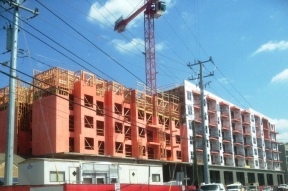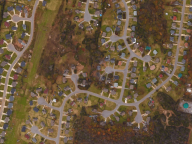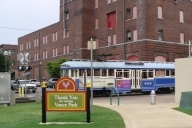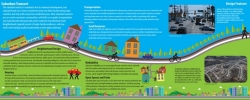Healthy Places - Development
Development is the altering of land. Examples of development are changing land from its natural state for use as farmland, a shopping mall or a subdivision. In some places, such as urban areas, planning or zoning guides development. In some places, typically rural areas, there are few checks or balances on development. Development and redevelopment can improve health outcomes and livability.

How is development connected to health?
How can development encourage placemaking?
How can development increase active transportation?
What is sprawl?
What is smart growth?
What is redevelopment?
What are brownfield sites?
How can anchor institutions lead?
What is my area Developmental District?
What about economic development?
Why conserve green space?
Why are zoning policies important to health?
What are some economic incentives for developers?
Government partners
Additional resources
Helpful documents
How is development connected to health?
Development patterns can influence healthy behaviors. More and more it is being recognized that good health doesn’t happen at the doctor’s office. Place is an important determinant of health. If places are developed to allow or even promote active transportation there is evidence it benefits health from increased physical activity and reduced chronic disease. How infrastructure is built and maintained impacts health status and access to health services. Without transportation options and transportation infrastructure, it is much more difficult for people to get to their medical appointments. People living in rural, suburban and urban areas have different access to routine physical activity, health care, healthy foods and places to reconnect with nature. Sustainable development is needed to ensure healthy places for future generations. The non-profit Global Wellness Institute's Build Well to Live Well report outlines this connection.
How can development encourage placemaking?
Placemaking pays attention to the physical, cultural and social identity of a place. Placemaking is an approach to planning, designing, building and maintaining public spaces in a way that focuses on the people that use and benefit from the space. When developing a place here are some features to consider than contribute to making places people want to spend time in:
- plazas,
- benches,
- parks,
- trees,
- landscaping,
- water features,
- historical markers,
- murals, and
- public art.
How can development increase active transportation?
Active transportation is getting around using human energy such as walking or biking. Active transportation benefits health from increased physical activity and reduced chronic disease. There is increased demand for developments with options for people to choose whether they walk, bike, ride or drive to get around such as:
- sidewalks,
- bike lanes,
- greenways, and
- transit.
What is a sprawl?

Sprawl is pattern of development. Many planners consider sprawl to be low quality growth and expansion. Sprawl is often described as having:
- low development density,
- separated homes, shops and workplaces,
- lack of activity centers and downtowns, and
- poor street connectivity.
According to Smart Growth America, individuals in compact, connected areas have greater economic mobility. People in these areas spend less on the combined cost of housing and transportation. People in compact, connected areas tend to live longer, safer, healthier lives than their peers in areas with sprawl. Sprawl has been linked to:
- reduced physical activity,
- reduced air quality,
- reduced social interaction,
- increased obesity,
- increased risk of traffic fatalities,
- increased emergency response times, and
- increased commute distances, times and costs.
What is smart growth?
Smart Growth America promotes “smart growth” as housing and transportation choices near jobs, shops and schools supporting local economies and protecting the environment. The U.S. Environmental Protection Agency suggests that smart growth covers a range of development and conservation strategies that help protect our health and natural environment and make our communities more attractive, economically stronger, and more socially diverse. Smart growth development can help create more economic opportunities, build great places where people want to live and visit, preserve the qualities people love about their communities and protect environmental resources.
What is redevelopment?
Redevelopment is simply repurposing a property from one use to another. Redevelopment often improves nearby property values. Sometimes redevelopment is an obvious choice. Other times, the economic marketplace, environmental contamination or public perception may hinder redevelopment.
What are brownfield sites?
Brownfield sites are defined as abandoned, idled or underused commercial and industrial properties where reuse or redevelopment is complicated by real or assumed contamination from hazardous wastes or pollution. Generally, brownfield sites exist in a city or town's industrial section, on locations with abandoned buildings or other former polluting operations. Small brownfields also may be found in many older residential neighborhoods or along rural roads and include gas stations and dry cleaners. The safe reuse of brownfield sites benefits communities and their economic development. Brownfield redevelopment can transform blighted properties in sustainable, productive reuses that leverage private investments, reuse existing infrastructure, reduce sprawl, revitalize neighborhoods and increase property values. Visit our Healthy Places Brownfields webpage for more information.
How can anchor institutions lead?
Anchor institutions are the major employers and property owners of a community. Anchor institutions such as government offices, universities, hospitals, factories, corporate headquarters and big box stores can be catalysts for economic and community development. These large entities can take on a variety of roles from building infrastructure to purchaser of local goods or even redeveloper of blighted real estate. Anchor institutions can assist communities’ health needs by supporting social determinants of health like affordable housing, neighborhood safety, community engagement and continuing education.
What is my area Development District?
Development Districts serve as the regional clearinghouses for federal programs in support of economic, housing and community development initiatives. Development Districts bring elected leaders from cities and counties together with leaders from other community organizations to address regional issues and to promote economic development. There are nine Development Districts in the State of Tennessee For more information, visit the Tennessee Development District Association's website.

What about economic development?
The Department of Economic and Community Development has several programs supporting quality of life improvements in communities such as Community Development Block Grants, Tennessee Main Street and ThreeStar. ECD funds initiatives to connect communities to advance economic development through funding and technical assistance. ECD has programs to support large industries and small businesses, and attract new business. ECD promotes Tennessee as a great place to make a living because at the heart of a competitive economic development strategy is community development.
Why conserve green space?
Even though there may appear to be a lot of green space left for expansion, environmental changes frequently occur and can cause problems for communities. Rapid loss of lands due to uncontrolled growth can undermine property values. Sprawling development can ruin important natural areas such as wetlands, prairies and forests. Conservation of lands protects the air, land and water from environmental pollution which is harmful to health. Green spaces such as wildlife refuges and state forests protect plants and animals. Conservation areas protect the scenic views which attract tourists, along with the jobs and economic opportunities created through spaces for hiking, hunting, fishing, bird watching and nature observation.
There are several options for preserving green space. Conservation development is controlled-growth land use that protects the area's natural environmental in perpetuity by preserving landscapes, sustaining farmland, protecting natural habitats for wildlife and maintaining the character of rural communities. Land trusts are voluntary conservation easements. Land trusts safeguard the land from development and sprawl. Families who have passed down the same property from generation to generation often like entering into a land trust to know their family home will remain similar to how they remember it. In addition to improved property values, many people feel their quality of life is improved when there is protected green space nearby.
Why are zoning policies important to health?
Zoning is a land use planning tool. Zoning has been used in urban, suburban and rural settings. Zoning means what can go where. What goes where can have a major impact on health. Zoning policy can influence neighborhood factors that lead to health outcomes such as physical activity, violent crime and obesity. Zoning can be used to restrict or prohibit certain land uses in certain areas. Zoning can help to slow sprawl. Zoning can encourage certain land uses. For example, mixed use zoning can increase density connecting people and places leading to more active transportation and physical activity. Zoning policies can encourage or require healthier options such as sidewalks, bike lanes, affordable housing or green spaces. Effective zoning policies can increase property values and decrease health inequities.
What are some economic incentives for developers?

As most developers are for-profit businesses, one strategy to guide new or redevelopment is to offer economic incentives to developers. Economic incentives are a local, state or federal government bearing costs to encourage development. Here are some examples of incentives:
- tax breaks,
- exemption or relief from regulations,
- public utility rate break,
- subsidized loans, or
- infrastructure improvements.
Economic incentives often change with the size and scope of a proposed development and the current fiscal market. While not all economists agree incentives are the best approach, there have been successful incentives that have benefited communities through:
- more affordable housing units,
- new jobs,
- redevelopment of blighted real estate,
- population growth, and
- infrastructure improvements.
Sustainable and health promoting development can have positive economic impacts on a community, bussinesses and individuals. The Tennessee Department of Health shares these economic returns in our Health Promoting Design: Return on Investment Toolkit.
Government partners
U.S. Environmental Protection Agency (EPA)
Smart Growth
www.epa.gov/smartgrowth
Additional resources
Tennessee Chapter of the American Planning Association (TAPA)
www.tnapa.org
Nashville Civic Design Center (NCDC)
www.civicdesigncenter.org
Urban Land Institute (ULI)
uli.org
Smart Growth America (SGA)
www.smartgrowthamerica.org
Local Government Commission (LGC)
Leaders for Livable Communities
www.lgc.org
Helpful documents
U.S. Environmental Protection Agency (EPA)
This is Smart Growth
www.epa.gov/sites/production/files/2014-04/documents/this-is-smart-growth.pdf (PDF)
American Planning Association (APA)
Healthy Planning
planning-org-uploaded-media.s3.amazonaws.com/legacy_resources/research/publichealth/pdf/evaluationreport.pdf (PDF)
Global Wellness Institute
Build Well to Live Well: Wellness Lifestyle Real Estate and Communities
www.globalwellnessinstitute.org/wellness-real-estate-communities-research (PDF)
Build Healthy Places Network
Partnerships for Health Equity and Opportunity: A Healthdcare Playbook for Community Developers
www.buildhealthyplaces.org/whats-new/healthcare-playbook-for-community-developers (PDF)
